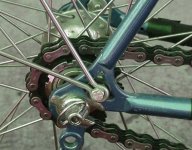fitek
1 kW
Did a quick search and didn't see a discussion on this...
What are the different chain sizes in use?
When looking for sprockets on the scooter sites and mcmaster-carr, I see various no. sprockets and chains. The scooter sites have no.25 and no.35. I've seen it mentioned that no.35 are used on go-karts.
What is used on bicycles? I know different sizes are used, but I've heard them described as 3/8", etc. Do these map to no.'d chains?
What are the different chain sizes in use?
When looking for sprockets on the scooter sites and mcmaster-carr, I see various no. sprockets and chains. The scooter sites have no.25 and no.35. I've seen it mentioned that no.35 are used on go-karts.
What is used on bicycles? I know different sizes are used, but I've heard them described as 3/8", etc. Do these map to no.'d chains?




